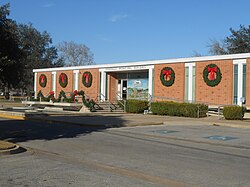Gonzales, TX
| Gonzales, Texas | |
|---|---|
| City | |

Gonzales' Municipal Building on St. Joseph St. was built in 1959 from plans by Emil Niggli and Barton Riley.
|
|
| Motto: "Where the fight for Texas liberty began" | |
 Location of Gonzales, Texas |
|
| Coordinates: 29°30′32″N 97°26′52″W / 29.50889°N 97.44778°WCoordinates: 29°30′32″N 97°26′52″W / 29.50889°N 97.44778°W | |
| Country | United States |
| State | Texas |
| County | Gonzales |
| Government | |
| • Mayor | Connie Kacir |
| • City manager | Sean Lally |
| Area | |
| • Total | 6.1 sq mi (15.7 km2) |
| • Land | 6.1 sq mi (15.7 km2) |
| • Water | 0.0 sq mi (0.0 km2) |
| Elevation | 285 ft (87 m) |
| Population (2010) | |
| • Total | 7,237 |
| • Density | 1,191/sq mi (459.9/km2) |
| Time zone | Central (CST) (UTC-6) |
| • Summer (DST) | CDT (UTC-5) |
| ZIP code | 78629 |
| Area code(s) | 830 |
| FIPS code | 48-30116 |
| GNIS feature ID | 1336672 |
| Website | www |
Gonzales is a city in Gonzales County, Texas, United States. The population was 7,237 at the 2010 census. It is the county seat.
Gonzales is one of the earliest Anglo-American settlements in Texas, the first west of the Colorado River. It was established by Empresario Green DeWitt as the capital of his colony in August 1825. DeWitt named the community for Rafael Gonzáles, governor of Coahuila y Tejas. Informally, the community was known as the DeWitt Colony.
The original settlement (located where Highway 90-A crosses Kerr Creek) was abandoned in 1826 after two Indian attacks. It was rebuilt nearby in 1827. The town remains today as it was originally surveyed.
Gonzales is referred to as the "Lexington of Texas" because it was the site of the first skirmish of the Texas Revolution. In 1831, the Mexican government had granted Green DeWitt's request for a small cannon for protection against Indian attacks. At the outbreak of disputes between the Anglo settlers and the Mexican authorities in 1835, a contingent of more than 100 Mexican soldiers was sent from San Antonio to retrieve the cannon.
When the soldiers arrived, there were only 18 men in Gonzales, but they refused to return the cannon, and soon men from the surrounding area joined them. Texians under the command of John Henry Moore confronted them. Sarah DeWitt and her daughter sewed a flag bearing the likeness of the cannon and the words "Come and Take It", which was flown when the first shots of Texan independence were fired on October 2, 1835. The Texians successfully resisted the Mexican troops in what became known as the Battle of Gonzales.
...
Wikipedia
